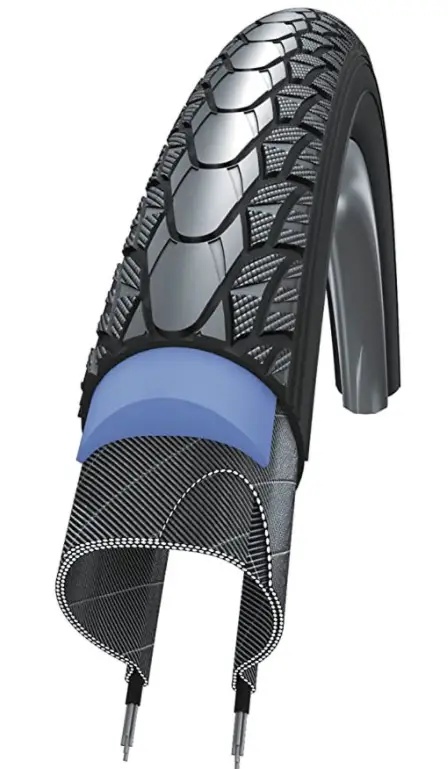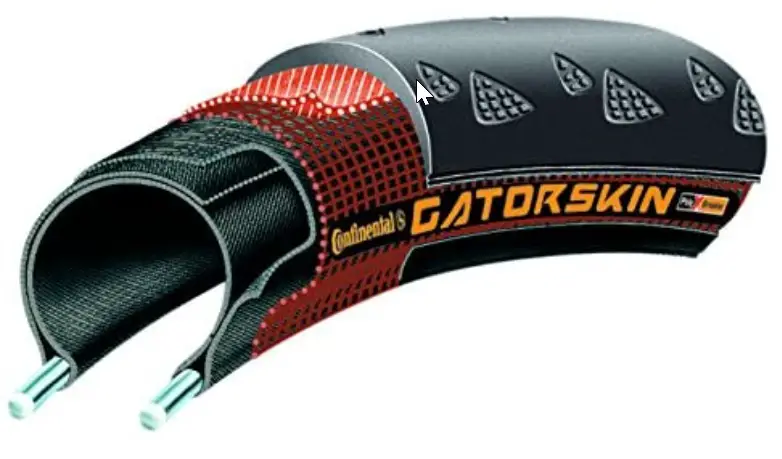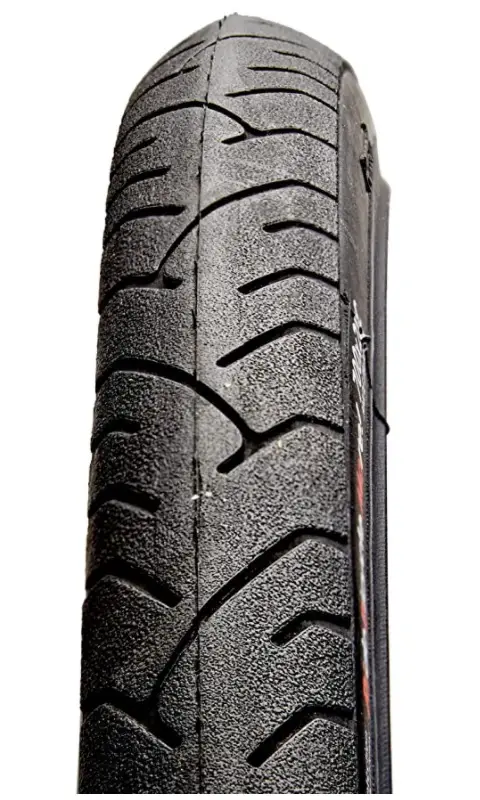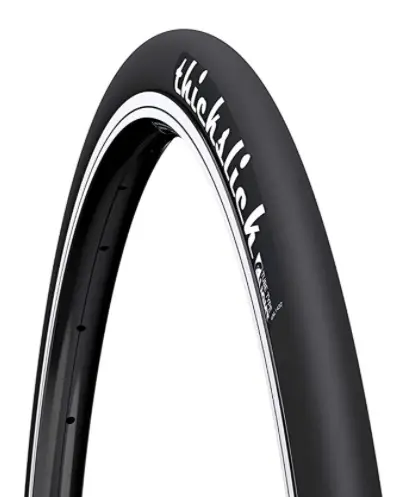A real concern when using your bicycle is how long the tires will last. When commuting, this question only magnifies as your tires can quickly become the most important component of your entire commuting rig.
How long do bike tires last? Bicycle tires typically last between 2000 and 3500 miles. Lightweight racing tires last from 800 to 1000 miles. Touring tires are rugged and can last 3500 to 4500 miles. The tire quality, road conditions, and how you take care of it all affect how long it will last.
Read on to learn more about your tires, how long they should last, and what to look for when replacing them. Also, find out which tires are the most durable and best fit for your ride!
Signs To Look For When It Comes To Replacing The Tires
A good set of tires can usually last the user a year or two. Unless you ride more than 20 miles a day, you can reasonably expect the tires to last more than one season. People with a shorter commute can often get as much as 3 or 4 years out of a good set of tires.
Electric bikes built for everything and priced for everyone. Shop Rad Power Bikes, America's #1 electric bike brand. Get out. Go further. Ride Rad.
However, here are some things to watch out for when it comes to your tires and warning signs letting you know it is time to replace them.
One of the most obvious is the wearing down of the tread pattern. With mountain bike tires, gravel tires, or touring tires, there is often a tread pattern on the central portion of the rubber that contacts the road surface. Visually, it is pretty easy to see when the tread pattern is wearing away.
Some tires even have wear bars just like the tires for your car, so keep an eye out for those, and if they start to appear, it’s time to replace them.
A special note about road tires is they are sometimes slick without the appearance of a tread pattern. When checking these for wear, visually inspect them; if they appear to be getting less rounded, it could indicate that they need replacing.
No matter what tires you use, it is always a great idea to inspect your tires for wear every few rides.

Look for any cracking in the sidewalls, gouging in the rubber, bubbles, or threads showing through. If you ever find these, it is advised that you replace your tires immediately. These can be relatively serious issues and can lead to a blowout, which could make you not only late to work but they are also potentially dangerous.
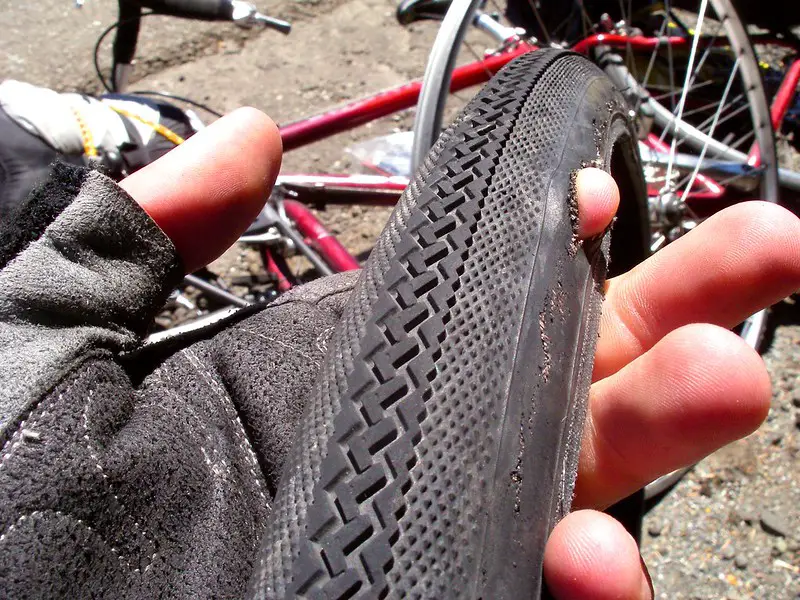
In a nutshell:
- Inspect tires about once every two weeks to look for signs of damage or wear.
- Make a mental note of tread patterns when new and look for visible signs of wear while inspecting your tires.
- Be careful to look over tires for any signs of cracking, gouging, bubbling, thread exposure, strange wear patterns, or anything else troubling. When in doubt, replace them immediately.
See below for a handy dandy list to help you care for your tires as well as what to look for indicating it is time to replace them.
How to make your bicycle tire last long?
- Ensure proper inflation every few days, especially when temperature changes are dramatic.
- Rotate your tires back to front about every 4 to 6 months. This will make sure you are getting the most out of your tires, as the rear one will usually wear faster than the front.
- Avoid hitting potholes and curbs as much as you can
- Don’t ride with a flat tire
Should I Replace Both the Front and Rear and Inner Tubes at The Same Time?
I always recommend that when you replace one tire, you go ahead and replace the other. This allows you to know each tire’s life and prevents you from having a mismatched set.

I also usually recommend that when replacing your tires, to replace the inner tube at the same time. This ensures that your tires and tubes are brand new, giving you peace of mind.
The Best and Most Resistant Tires For Commuting
Schwalbe Marathon Plus Smart Guard: These are considered the gold standard for commuting and are an excellent option for the daily commuter.
They have a durable wire bead, come in various sizes from 16in to 700c, widths from 25c to 45c, and offer excellent puncture protection.
The only drawback to these guys is that they are relatively slow-rolling. 50 bucks a tire isn’t the cheapest, but you can’t complain too much, especially how hard it takes to get a flat with the extra 5mm of rubber between the tread and tire carcass. Slap on a set of these if you want serious flat protection.
Continental Gatorskin: Looking for great flat protection with minimal rolling resistance? Look no further than Gatorskins. A favorite of commuters for years, Gatorskins offers a perfect balance between flat protection and speed.
They will not protect you as much as the Schwalbe mentioned above, but you will get to where you are headed faster.
They come in a variety of sizes, such as 26in, 27in, and 700c, with widths from 23c to 32c. They come in a durable wire bead or a lightweight folding bead style, saving storage space when not on the bike.
At about $40 per tire, these are a favorite of commuters worldwide.
Specialized Crossroads Armadillo: If your commute takes you across various terrains other than regular asphalt then these are your best choice.
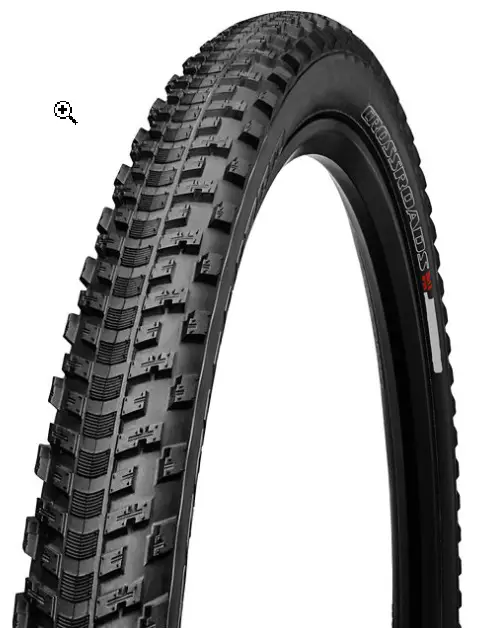
With rugged casing, aggressive tread, and well-supported side knobs, these guys are ready to tackle gravel, dirt, and pavement all in one ride. Sure, you will increase your rolling resistance, but the traction gained in slippery mud or on icy road conditions can be worth the trade-off.
These make a great option for winter commuting and come in various sizes, such as 26in, 650b, and 700c. Their wide stance at 38c and rugged wire bead will not only ensure great traction but lasting reliability.
At $40 per tire, they are also a great deal. The only drawback is they are only available through Specialized and authorized dealers.
Panaracer Ribmo: Ribmo stands for Ride Bike More, and these certainly do a great job. With excellent flat protection and minimal rolling resistance, these are a great competitor or alternative to the famed Gatorskins.
They are extremely tough and long-lasting using a special compound from Panracer called Mile Cruncher. This is one of the hardest compounds used by the company providing excellent flat protection while also increasing the lifespan of the tires.
They come in folding and wire bead models with 26in, 650b, and 700c sizes with widths of 23c -36c.
If you are seeking a long-lasting tire that won’t break the bank at around $35 per tire, look no further.
WTB Thickslick: Looking for a purely slick tire to minimize rolling resistance to the max? Then you should consider a pair of WTB Thickslicks.
These tough tires offer a fair amount of puncture protection while allowing you to roll fast. They also look super cool while doing so and are available in 26in, 650b, 700c, and 29in options. On top of that, they have widths from 23c to 50c to fit all your commuting needs.
Best of all, they are super affordable and come in two models: the Comp ($33) and Flat Guard ($37), offering a bit more protection.
Michelin Protek Urban: If you live in an area that experiences extremely wet conditions, these will probably be your best choice.
Made from Michelin’s proprietary compound borrowed from the Pro 4 Grip Service Course road tires, they stick to the wet ground like velcro.
They excel in the rain while affording superior flat protection with minimal rolling resistance. They come with a durable wire bead in 20in, 26in, and 700c options with widths from 28c to 40c.
The cherry on top is their affordability at $32 per tire.
Beware of Cheap Tires!
When looking to put on new tires or replace them on your bicycle, it is a great idea to ensure that you buy the best you can reasonably afford. This is especially true when putting tires on your commuter bike, as you do not want to deal with flats on the way to work constantly.
Some cheap tires will run you for less than $20, but these should not be used as a long-term option. They are great for a temporary fix until you can save up for a nice pair of tires but do not rely on them for the long term.
Generally, the build quality is terrible on cheap tires using inferior rubber. This leads to them wearing out much quicker and more prone to flats as they are often more tender than a nicely cooked chicken breast.
Happy riding!

